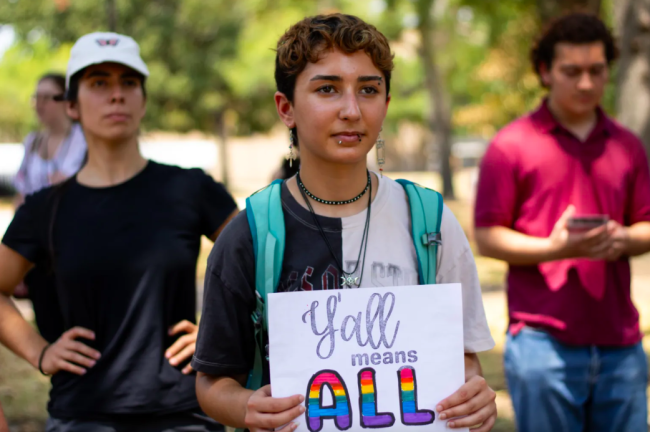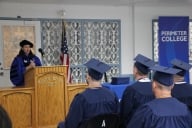You have /5 articles left.
Sign up for a free account or log in.

A student holds a sign reading “y’all means all” at a protest against the University of Houston’s closure of its LGBTQ Resource Center last summer.
Raphael Fernandez/The Cougar
For public colleges and universities in Texas, Jan. 1 isn’t just the start of the new year. It’s also the day the state’s anti–diversity, equity and inclusion bill, SB 17, will go into effect—a development many institutions have spent months preparing for.
But that preparation has varied greatly depending on the institution. Some universities jumped into overdrive as soon as Governor Greg Abbott signed the bill in June, immediately cutting DEI and related offices, such as multicultural and LGBTQ+ resource centers. Other institutions remain in limbo, unsure what if any actions to take ahead of the Jan. 1 deadline.
The result is a messy patchwork of campus policies, procedures and approaches designed to ensure compliance with the new law. Through interviews, analyses of university websites and reviews of official materials including press releases and memos, Inside Higher Ed has compiled this resource to provide a glimpse into what Texas’s 36 public four-year universities have done so far to implement SB 17. Hover over an institution’s name to learn what the DEI ban means for its campus.
Tracking Changes Under SB 17
In addition to the changes made on each campus, most of the state’s higher education systems—the University of Texas system, the Texas A&M system, the University of Houston system and the University of North Texas system—released systemwide guidance for SB 17, answering frequently asked questions about what is permissible under the new law. Some institutions actually made changes ahead of the bill’s passage, including removing DEI statements from hiring and admissions resources after the governor’s office instructed them to do so in February. (This paragraph has been updated to correct one of the state system names; it's University of North Texas, not Texas State University, as originally written.)
The law does not affect student organizations, which are allowed to continue holding events and conducting activities based on race, sexual orientation and national identity, even as universities are banned from sponsoring those events. Some college officials have pointed out that the change puts a bigger onus on student groups to continue the traditions that used to be the purview of multicultural affairs offices.
“The law allows for student organizations to have greater latitude into how they support certain initiatives and programs that are important to them,” said Lawrence Schovanec, president of Texas Tech University. “When we celebrated Hispanic Heritage Month [Sept. 15 through Oct. 15], we worked with the Hispanic student society and other student groups. They had to take a leadership role in leading events that used to fall within the domain of the university.”
Universities are still allowed to hold celebrations for federally recognized months and holidays, including National Hispanic Heritage Month.
Graham Garner, a spokesperson for Stephen F. Austin State University, which recently joined the University of Texas system, said that the university’s personnel are working on informing student groups of the changes so that they are prepared to take on that extra responsibility.
“If they have questions about what they can do and how they can organize a variety of activities, there has been support for them to do so, just like any other organization on campus,” he said.
At some institutions, this shift has already begun taking effect; at Texas A&M University, a group of LGBTQ+ student organizations announced that they would take the reins on events previously held by the Pride Center, such as Lavender Graduation.
But organizing an event is a significant responsibility for students who often balance those leadership roles with jobs, schoolwork and other extracurriculars. And it could be challenging for a club to add previously university-sanctioned events into an existing calendar of activities and meetings.
“It puts a lot of burden on those organizations,” said Kasey Corpus, Southern policy and advocacy manager for Young Invincibles, a progressive youth advocacy nonprofit.
Who Has a Say?
Some students and former DEI staffers have complained that they were not included in discussions of the pre-emptive changes made at their universities.
Pavitra Kumar, a student at the University of Texas at Austin, said there have been very few examples of administrators speaking “directly to students to see what they would feel safe and comfortable with.”
On top of that, communication to students about the changes at UT Austin—which include renaming the Division of Diversity and Community Engagement the Division of Campus and Community Engagement—has been sparse. She noted that the university’s communication with students about this change came after the end of finals week, when most students were already off campus and perhaps no longer checking their email.
“SB 17 will be going into effect when students are not on campus to see these changes … this can come as a sort of shock to students, and we really need to focus on rebuilding and educating students on what this might look like,” Kumar said.
Definitely someone else was making the decisions. We were not asked for input or suggestions.”
—Gilbert Carrasco, Texas Tech University
Staff members from now-dissolved DEI offices also say their voices were left out of conversations about how to move forward. Gilbert Carrasco, who previously served as the director of the Office of LGBTQIA Education and Engagement at Texas Tech, said that he was told abruptly in August that the office was closing. He was offered an alternative position but chose not to take it and will leave the institution at the end of December.
Carrasco said he was not consulted about where the office’s resources—which include information for LGBTQ+ students, as well as materials related to sexual health, insurance and emancipation from abusive parents—could be relocated.
“Definitely someone else was making the decisions. We were not asked for input or suggestions. I offered mine, and of course nothing was given back,” he said.
Months after the office’s closure, he said, students are still coming to him and his former assistant director to find those resources; they have had no clear communication about where to go now.
Schovanec concurred that most of the decisions were made by administrators.
An employee at the University of North Texas, who asked to remain anonymous to protect their job, agreed that a wealth of resources will no longer be available on UNT’s campus in the new year, now that the Multicultural Center and the Pride Alliance have been dissolved.
“Gender-affirming supplies—like binders, things like that—are going to disappear or possibly disappear,” the employee said. So, too, will designated spaces for queer students and students of color, as the former spaces of both centers will now be home to various other university offices.
The employee noted that staff in those two centers had no input into what would happen to them; they heard nothing until a few weeks ago, when they were told that the centers would ultimately be closed.
Staff members have been given the opportunity to move to other roles in a newly created office, the employee said, which would represent demotions from their current job titles.
When asked whether they could confirm these demotions, a UNT spokesperson said, “Media relations does not have the specific names and titles, only that all were placed at the time the change took place.”
“It’s almost like a setup to push people out,” the anonymous UNT employee said.
Although most of the changes have been made ahead of the Jan. 1 start date, students and staff remain confused about what may or may not be permissible in a post–SB 17 world.
Diversity, equity, inclusivity—those three words in particular are very triggering words, and people are unsure if they can be used in natural language. I would hesitate to use those words.”
—Anonymous employee, Texas A&M at Corpus Christi
Yvette Salazar, a student at the University of Texas Rio Grande Valley’s Brownsville campus, said that faculty have been trying to figure out how they can create safe spaces for queer students, but they are unsure if that’s possible without breaking the law.
“There are faculty that do care, but it’s just working a way around what can and can’t be done and be said,” she said.
An employee at Texas A&M University at Corpus Christi, who asked to remain anonymous to protect their job, said there has been little change within their division—except for plans to remove a DEI statement from the website. But as someone who works in a student-facing role, they that they could get in trouble for informing students about “diverse” media or “diverse” scholars— even though the bill does not explicitly say so. Instead, they said they might be more inclined to refer specifically to, say, “Black scholars” or “LGBTQ media.”
“From everything I’m hearing around me, diversity, equity, inclusivity—those three words in particular are very triggering words, and people are unsure if they can be used in natural language. I would hesitate to use those words,” the employee said. “That’s just what we’ve been going with so far. I’m not sure if we’re overreacting or if we’re on point.”
Katherine Knott contributed reporting to this article.








